
Marine Fighter Attack Squadron 323 (VMFA-323) is an aircraft carrier-based aviation squadron of the United States Marine Corps. The squadron is equipped with the McDonnell Douglas F/A-18C Hornet and is based at Marine Corps Air Station Miramar, California, United States. It falls under the command of Marine Aircraft Group 11 (MAG-11) and the 3rd Marine Aircraft Wing but deploys with the U.S. Navy's Carrier Air Wing 17 (CVW-17). Their tail code is WS and their radio callsign is Snake.

Marine Fighter Attack Squadron 311 (VMFA-311) is a United States Marine Corps fighter attack squadron consisting of F-35C Lightning II. Known as the "Tomcats", the squadron is based at Marine Corps Air Station Miramar, California and falls under the command of Marine Aircraft Group 11 (MAG-11) and the 3rd Marine Aircraft Wing.

Marine Fighter Attack Training Squadron 502 (VMFAT-502) is a United States Marine Corps fighter attack training squadron flying the Lockheed Martin F-35 Lightning II. Known as the "Flying Nightmares", the squadron maintains the history of Marine Attack Squadron 513 (VMA-513) which dates back to World War II and was decommissioned on 12 July 2013. The squadron is based at Marine Corps Air Station Miramar and falls under the command of Marine Aircraft Group 11 and the 3rd Marine Aircraft Wing
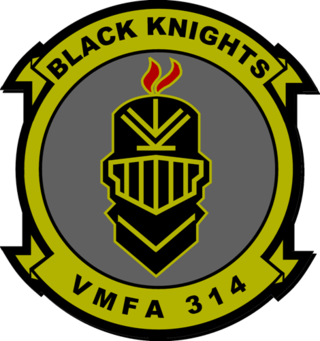
Marine Fighter Attack Squadron 314 (VMFA-314) is a United States Marine Corps F-35C Lightning II squadron. The squadron, known as the "Black Knights", is based at Marine Corps Air Station Miramar, California and falls under the command of Marine Aircraft Group 11 (MAG-11) and the 3rd Marine Aircraft Wing, but deploys with the US Navy's Carrier Air Wing Nine (NG).

Marine Fighter Attack Squadron 312 (VMFA-312) is a United States Marine Corps F/A-18C Hornet squadron. Also known as the "Checkerboards", the squadron is based at Marine Corps Air Station Beaufort, South Carolina and falls under the command of Marine Aircraft Group 31 (MAG-31) and the 2nd Marine Aircraft Wing. The Radio Callsign is "Check."

Marine Fighter Attack Training Squadron 501 (VMFAT-501) is a training squadron in the United States Marine Corps, consisting of 27 F-35B Lightning II aircraft and serves as the Fleet Replacement Squadron. Known as the "Warlords," the squadron is based at Marine Corps Air Station Beaufort, South Carolina and falls administratively under Marine Aircraft Group 31 and the 2nd Marine Aircraft Wing. The squadron has assumed the lineage of VMFA-451 which was originally known as the "Blue Devils" and saw action during World War II and Operation Desert Storm. They were decommissioned on 31 January 1997.
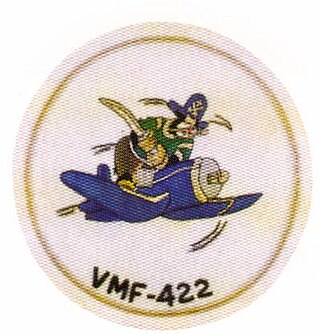
Marine Fighting Squadron 422 (VMF-422) was a Vought F4U Corsair squadron in the United States Marine Corps. The squadron, also known as the "Flying Buccaneers", fought in World War II but is perhaps best known for its role in the worst accident in naval aviation history when 22 of the squadron's 23 aircraft were lost flying through a typhoon on 25 January 1944. After being reconstituted, the squadron participated in the Battle of Okinawa. VMF-422 was decommissioned on 7 April 1947. Since that date, no other Marine Corps squadron has carried the lineage and honors of VMF-422.

Marine Fighter Attack Squadron 351 (VMFA-351) was a fighter squadron in the Marine Forces Reserve. The squadron was based at Naval Air Station Atlanta and participated in action during World War II and was decommissioned in 1975.

Marine Fighter Squadron 113 (VMF-113) was a fighter squadron of the United States Marine Corps during World War II and in the Marine Forces Reserve until 1965. Known as the "Whistling Devils", the squadron participated in aerial combat over the Marshall Islands in 1944 and took part in the Battle of Okinawa in 1945. It was decommissioned on 30 April 1947 following the end of World War II but was reactivated in the Reserves a few years later only to be deactivated for the last time in 1965.
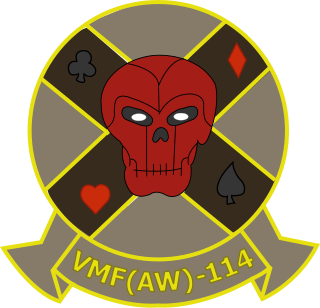
Marine All-Weather Fighter Squadron 114 was a squadron of the United States Marine Corps that was originally commissioned during World War II. Nicknamed the "Death Dealers", the squadron saw the most action during the war providing close air support during the Battle of Peleliu. The squadron remained on active duty until being decommissioned in 1963.

Marine Fighter Squadron 123 (VMF-123) was a fighter squadron of the United States Marine Corps during World War II and later in the Marine Forces Reserve. Known as the "Flying Eight Balls," the squadron fought at Guadalcanal, Iwo Jima, and Okinawa and served as a training squadron for replacement pilots during the Korean War. The squadron was decommissioned on 31 October 1965 at Naval Air Station Los Alamitos.

Marine Transport Squadron 216 (VMR-216) was a reserve cargo squadron of the United States Marine Corps that was based out of Washington. Known as the "Bulldogs", VMR-216 started out as a fighter squadron and participated in numerous combat engagements in the Pacific Theater during World War II to include the Battle of Guam and the Battle of Iwo Jima. The squadron was decommissioned shortly after the end of the war but was reactivated in 1946 as part of the Marine Air Reserve. The squadron remained in the Reserve until being decommissioned on 21 December 1972.
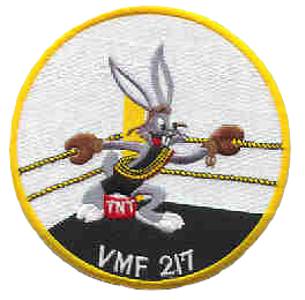
Marine Attack Squadron 217 (VMA-217) was a fighter squadron of the United States Marine Corps that was activated and fought during World War II. Known as "Max’s Wild Hares", they fought in many areas of the Pacific War including the Battle of Iwo Jima. Following the surrender of Japan, the squadron was deactivated on 10 March 1946. They were briefly reactivated as part of the Reserves but were again deactivated in 1964 and remain in an inactive status today.

Marine Fighting Squadron 222 (VMF-222) was a fighter squadron of the United States Marine Corps that was activated and fought during World War II. Known as "The Flying Deuces," they fell under the command of Marine Aircraft Group 14 (MAG-14) and fought in many areas of the Pacific War, including the Philippines campaign (1944–45) and the Battle of Okinawa. During the war, the squadron was credited with shooting down 53 enemy aircraft and was the sister squadron to VMF-215. They were deactivated on 31 December 1949.

Marine Fighting Squadron 511 (VMF-511) was a fighter squadron of the Marine Corps and Marine Forces Reserve during World War II and the Cold War which flew aircraft types such as the F6F Hellcat, F4U Corsair, and the F-8 Crusader. They were originally activated during World War II and fought during the Battle of Okinawa and the Battle of Balikpapan (1945). They specialized in close air support and during the course of the war were credited with only one plane shot down.
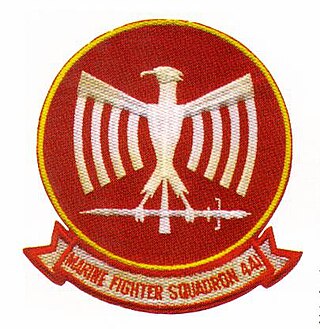
Marine Fighting Squadron 441 (VMF-441) was a fighter squadron of the Marine Forces Reserve during the Cold War. Originally commissioned during World War II, the squadron fought during the Battle of Okinawa. Nicknamed "The Blackjacks", VMF-441 was credited with 49 planes shot during the course of the war. Following the surrender of Japan, the squadron was decommissioned on 11 July 1946. They were reactivated in the Marine Air Reserve and were based out of Naval Air Station Niagara Falls, New York.

Marine Attack Squadron 233 (VMA-233) was an A-4 Skyhawk attack squadron in the United States Marine Corps. The squadron, also known as the "Flying Deadheads", were part of the Marine Forces Reserve and were based at Naval Air Station Norfolk, Virginia until their decommissioning in 1969. Originally activated during World War II, they fought in many areas of the Pacific War including the Battle of Guadalcanal as part of the Cactus Air Force, the Battle of Okinawa and the Battle of Balikpapan (1945). They were the only Marine Corps squadron to have three commanding officers killed during the course of the war and were credited with downing 8 Japanese aircraft. Following the surrender of Japan, the squadron was decommissioned on 10 March 1946. They were reactivated as part of the Reserves but were again decommissioned in 1969.
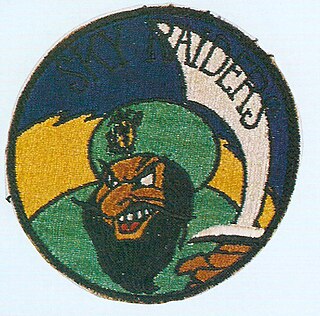
Marine Fighting Squadron 452 (VMF-452) was a fighter squadron of the United States Marine Corps that was commissioned and fought during World War II. Known as the "Sky Raiders", they flew the F4U Corsair, and the Grumman TBF Avenger, fell under the command of Marine Carrier Group 5 (MCVG-5) and fought in the Battle of Okinawa. The squadron is best known for being aboard the USS Franklin (CV-13) when she was severely damaged by Japanese kamikaze planes of the coast of Okinawa on 19 March 1945. VMF-452 was deactivated on 31 December 1949 and has remained in an inactive status since.

Marine Fighter Attack Squadron 124 (VMFA-124) was a flying squadron in the Marine Forces Reserve based out of Naval Air Station Memphis flying the Douglas A-4 Skyhawk. They were part of Marine Aircraft Group 42 and were decommissioned on 19 June 1999.

Marine Fighting Squadron 213 (VMF-213) was a reserve fighter squadron in the United States Marine Corps. Nicknamed the "Hell Hawks", the squadron fought during World War II in the Philippines and at the battles of Iwo Jima and Okinawa. With its assignment to the USS Essex (CV-9) and Air Group 4, VMF-213 along with VMF-124 was one of the first two Marine squadrons to augment carrier air groups during World War II. The squadron was credited with downing 117 enemy aircraft during the war.





















